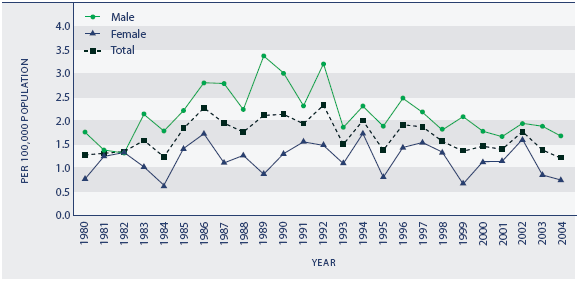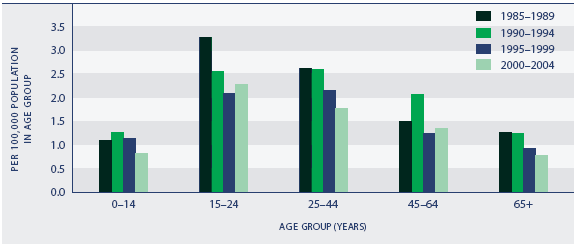Assault mortality
Definition
The number of people who have died as a result of assault or intentional injury, per 100,000 population.
Relevance
Reducing interpersonal violence in families and communities is critical to social and personal wellbeing. This indicator measures deaths resulting from violence, the tip of the violence pyramid. Young children and youth are particularly vulnerable.
Current level and trends
In the five years to 2004, 279 people died as a result of assault or intentional injury, a decline from 293 people in the previous five-year period and from 347 people in 1990–1994. The provisional age-standardised assault mortality rate for 2004 was 1.2 per 100,000 people, down from 1.4 per 100,000 in 2003. In the early 1980s, the assault mortality rate was around 1.5 per 100,000. It increased to around 2.0 per 100,000 between 1986 and 1992, and fell back to around 1.5 per 100,000 between 1998 and 2003. It should be noted that rates based on small numbers are volatile, and trends can be difficult to discern over the short term.
Figure SS1.1 Age-standardised assault mortality rate, by sex, 1980–2004

Source: Ministry of Health, New Zealand Health Information Service
Note: 2004 data is provisional
Age and sex differences
Five-year average annual assault death rates for the period 2000–2004 were highest among youth aged 15–24 years (2.3 deaths per 100,000 population), followed by adults aged 25–44 years (1.8 per 100,000) and those aged 45–64 years (1.3 per 100,000). Older people aged 65 years and over and children under 15 years had the lowest rates (0.8 per 100,000 for each age group). For children, the risk of dying from assault or intentional injury is highest at younger ages. In the five years to 2004, the assault death rate for children under 5 years was 1.6 deaths per 100,000, four times higher than the rate for 5–14 year olds (0.4 per 100,000). In all age groups, rates were lower in the period 2000–2004 than they were in the late 1980s.
Males are more likely than females to die from assault or intentional injury. The provisional 2004 age-standardised death rate was 1.7 per 100,000 for males, more than double the rate of 0.7 per 100,000 for females. The rise in the assault mortality rate in the late 1980s and early 1990s was the result of an increase in the male rate over that period.
Figure SS1.2 Five-year average annual assault mortality rates, by age group, 1985–1989 to 2000–2004

Source: Ministry of Health, New Zealand Health Information Service
Note: 2004 data is provisional
Ethnic differences
Māori are considerably more likely than non-Māori to die as a result of assault or intentional injury. In 2004, the age-standardised rate for Māori was 2.9 deaths per 100,000 compared with 0.8 per 100,000 for non-Māori. The age-standardised rate for Māori males (4.7 deaths per 100,000) was almost four times higher than the rate for Māori females (1.2 per 100,000).
In the five years from 2000 to 2004, Māori children under 15 years died from assault or intentional injury at an average annual rate of 1.4 deaths per 100,000 children. Over the same period, non-Māori children died at an average annual rate of 0.6 per 100,000 children.
International comparison
OECD homicide rates are standardised to the 1980 OECD population and differ from the rates shown in this indicator. In 2002, the OECD average homicide death rate was 2.0 deaths per 100,000 for males and 1.0 per 100,000 for females. The New Zealand homicide rates were lower than the OECD average for males (1.8 per 100,000) and higher than average for females (1.1 per 100,000). Australia and Canada had higher male homicide rates than New Zealand (2.0 and 2.1 per 100,000, respectively), while the United Kingdom had a lower male rate (1.2 per 100,000). The United Kingdom and Canada had lower female homicide rates than New Zealand (0.5 and 0.8 deaths per 100,000, respectively), while the Australian rate for females was the same (1.1 per 100,000). Death rates from homicide are highest in the United States; the rate for males in 2002, at 11 per 100,000, was five times greater than the OECD average, while the female rate of 3.2 per 100,000 was three times greater.
International comparison information for child maltreatment deaths is not available on an annual basis. Results of a 2003 UNICEF study of child maltreatment deaths in rich countries in the 1990s showed that New Zealand had the third highest child maltreatment death rate (1.2 deaths per 100,000 children under the age of 15 years).
|


